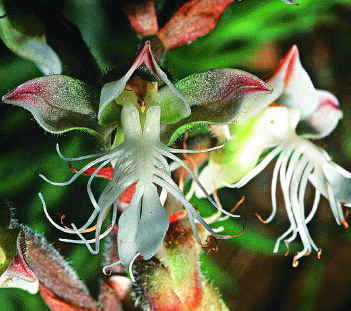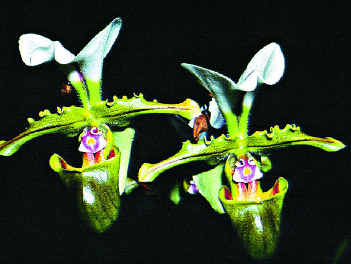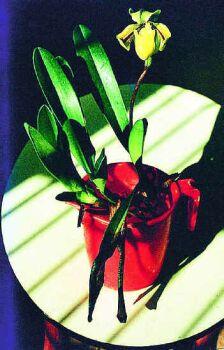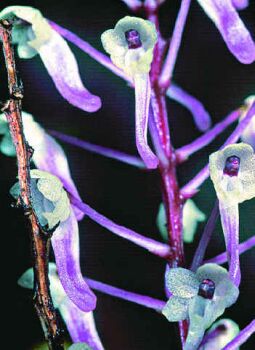Orchid haven
The Nilgiris is a prime habitat for numerous species of these flowers, providing a feast for the eyes, says TARUN CHHABRA. |
|
THE Nilgiris has some of the most varied ecosystems — from the shola-grassland "climax" ecosystem, the wet evergreen "rain forests" of the western slopes, the moist and dry deciduous jungles, to the lowland scrub forests and savannah. Not surprisingly then, this mosaic landscape is a prime habitat for numerous species of wild orchids. More precisely, over 120 species representing 60 genera, out of the more than 200 species found in peninsular India. Added to this is the fact that 10 species are endemic.
There are also some species that have their closest relatives only in the distant Himalayas and yet others with cousins in southeast Asia and Sri Lanka. In the Nilgiris, the bulk of the orchids are residents of the large forests on slopes and foothills. The upland shola-grassland have comparatively lesser number of species, albeit rare and endangered ones. The paucity in this area is perhaps due to the low temperature and humidity along with the fact that the typical sholas are receding over the past several thousand years.
|
| A very rare epiphyte, endemic to the upper Nilgiris - Robiquetia josephiana (Manilal & Satish) |
John Lindley (1799-1865) is considered to be the father of modern orchidology and he named several species sent to him by collectors from the Nilgiris like Robert Wight (who was actually a surgeon with the East India Company, but went on to become one of the greatest botanists), Van Rheede, Beddome, Jerdon, Barnes and others. In modern times, eminent botanists like J. Joseph, Manilal & Sathish Kumar have continued the tradition of naming genera and novel species of orchids from the Nilgiris and adjacent areas.

The exquisite "jewel" orchid - Anoectochilus elatus (Lindl). |
Orchids are biologically highly complex plants with an evolutionary history of millions of years. They grow on land — terrestrial, on trees — epiphytic (not parasitic however), on rocks — lithophytic (many are both epiphytic and lithophytic). Very few actually grow on decaying organic matter — saprophytic. The common factor amongst orchids is that they all have three sepals and three petals like some other families. But what distinguishes them both morphologically and botanically from all other plants is that one of the petals is strikingly different and called the lip. The astonishing variations in the morphology of the lip have enabled them to be classified under different groups or genera. This has also certainly given them the status of the most sought after flowering plants in the world. In some species, the lip resembles closely an old fashioned lady's slipper and thus is commonly called by this sobriquet. Others have the lip totally resembling a female insect of one of the principal pollinating species. This misleads the male insect into pseudo-copulation and thus effects the process of pollination. In most cases, the lip is the distinctive and "seductive" part — to the pollinator. |
Its trade
In addition to the lip form, the other most attractive facets of orchids are their striking colour combinations. Perhaps every possible shade except black is represented. The aim of the unique morphology and colouring patterns is not however to attract humans, but specific pollinating insects. For this reason, pollination can often fail and the seed not set, due to the fact that the specific pollinator has not visited the plant. Hence these pollinators have to be protected if the orchids themselves are not to disappear. Nevertheless, humans are attracted and intrigued towards these plants — a small country like Thailand earns foreign exchange worth Rs.168 crores annually from the orchid trade. This country has a base of fabulous looking natural species and with new tissue culture and marketing techniques, has helped achieve this success. The species marketed are new hybrid varieties. Tamil Nadu is one of the few States with a specialised orchidarium — situated at Yercaud (Shillong in the north-east has the best one).
Orchids are often called as the "aristocrats" among flowers. Although orchids as flowers of rare beauty and their cultivation have become popular only in more recent times, indigenous communities have used them since ancient times. And not just as objects of sheer beauty, but for a variety of practical purposes. Confucius mentioned them as plants of great refinement and it was Greek philosopher Theophrastus, who first coined the name " orchis" from which the word orchid is derived. A well-known orchid genus vanda , has its name derived from Sanskrit.
Uses
 spider-like ground orchid - Habenaria rariflora (A. Rich). spider-like ground orchid - Habenaria rariflora (A. Rich).
|
The indigenous people of the upper Nilgiris — the Todas, have used different species for specific purposes. For example, they have consumed the dried and powdered tubers of the terrestrial orchid Satyrium nepalense as an energising tonic. The Toda name for this grassland species is Ezhtkwehhdr — which literally means "bullock's horns". This name refers to the bullock horn-like resemblance provided by the twin spurs of these flowers. As very few orchid species have double spurs and at the back portion of the flowers, the Todas were very much aware of this botanical oddity, along with their medicinal value. Orchids could have utilitarian aspects as well — the species Calanthe triplicata, with its enormous leaves, has been used to fabricate a vessel to hold honey harvested within the forest. And the Toda name for this species translates aptly as: "honey leaves"!
In the Nilgiris, you can see orchids flowering in their natural habitat right through the year. Of course, the wet season provides the "peak" for them to bloom in profusion — especially the terrestrial species. The Nilgiris has 17 species of orchids belonging to the Habenaria genus and it is usual to see hundreds of these, flowering side by side on a single grassy and rocky slope. And these could be representing half a dozen species — all with a bizarre morphology. Some of these resemble an elephant with a trunk, a spider and another, a hooded doll. Incredibly, these species complete their flowering cycles within a few weeks and make way for other plants of other families. No selfish desire to prolong their life cycles here! |
A rare ground orchid
Disperis neilgherrensis has blooms that are striking beyond belief. They look like as if Donald duck has stepped right out of a comic book! Even amongst epiphytes, mass flowering provides for a veritable feast for the eye.
Coelogyne nervosa paints entire cliff faces white in August and the gorgeous
Aerides crispa with fragrant pink and white flowers, makes inanimate looking rocks and boulders come to life during the dry season.

A lady's slipper orchid.
|
Among the endemic species, we were able to relocate Liparis biloba recently. Another striking species Peristylis aristatus was also found, thus extending its range into the Nilgiris. The "jewel" orchid Anoectochilus elatus is a fabulous species with golden coloured lateral sepals (hence presumably, the "jewel" appendage to the name) and the rest of the flower is white and very striking. Another rare species, Robiquetia josephiana (Manilal & Sathish) was found in the Nilgiris and is endemic to this and adjacent areas. There is one of the smallest genera amongst orchids — called Sirhookera, commemorating the pre-eminent botanist J.D. Hooker. This genus consists of only two species and both are represented in the Nilgiris. There are however, alarmingly, some species like Bulbophyllum kaitiense that have not been located for over 100 years. On the positive side, there may yet be others awaiting detection and description. But unless the natural orchid habitat of the Nilgiris is saved from continuing destruction, several species are doomed to extinction. |
The Orchid that lived in a human skull! DAKSHA HATHI invited you to visit the bizarre and amazing world of the orchid thieves and orchid lovers
If you adore mysteries and deathly tales, you should make friends with the orchid! No other plant, except the tulip and the rose, have caused men, women, robbers, thieves and weird people to behave so abominably or so funnily!
The Vanilla Orchid, was supposed to give strength to the Aztecs. So they drank vanilla mixed in chocolate! The name 'orchid' comes from the Greek word orchis, ''testicle.'' In the nineteenth century orchids were collected by the ton! Once, four thousand trees were cut down for the orchids growing on them. One greedy collector of orchids was suspected of having sent one hundred thousand orchids to England, to make money.
Tragically, many of them died. One strange collector named Wilhelm Micholitz sent an orchid back home, which was growing in a human skull! It was auctioned for a massive sum, along with its bizarre container! Here are some more mad hatters of the Orchid World.
Meet Joe Kunisch, a man who became mad about orchids after he first saw a single plant on the windowsill of his kitchen forty years earlier! Then he could not stop growing them, first a red and then a pink one and finally his basement got filled up with these magical plants! Then he got a greenhouse with about 200,000 orchids! Another mad orchid lover became so obsessed that his wife was furious. She told him to choose between her and the orchids and he told her that she could leave whenever she wanted to!
A Japanese real estate developer named Hiroshi Ikarashi is so mad about his orchids that when an early morning earthquake tore down his house, he ran out naked to check the state of his orchids in the greenhouse! The greenhouse was broken but the orchids were fine! Only after he had checked up on them, he wondered where his wife was in the rubble!
Perhaps the most astonishing orchid mad hatters are Galfrid Clement Keyworth Dunsterville and his wife Nora, who climbed a 5000-foot-high sandstone plateau that rises above a jungle, to collect orchids. They wrote a six-volume Venezuelan Orchids Illustrated book. They endured a five-day stretch on foot, through swarms of biting insects, as local porters brought them to the foot of the plateau.
Ticks tore at their skins, as they clawed their way to the top. On the rim of the plateau they struggled through wild and dangerous jungle land for two weeks, to find new and exciting orchids!
On one dreadful day Nora fell through the false floor of the jungle and yelled! Luckily there was a narrow ledge overlooking a smelly abyss that saved her. One night the carefully collected orchids were attacked by leaf-cutting ants and many were destroyed.
But inspite of the hardships and the danger and the terrors, Nora lived to tell the admiring world about how she had bathed in a stagnant jungle sinkhole, covered with mud and smelling of fresh tapir dung! All this for orchids! And it wasn't just the money for many of them. It was just a weird, wild, magical power of the orchids that maddened them! These gorgeous flowers are used in making foods, clothing, cosmetics, perfumes, packaging, medicines, paint pigments, and food flavourings! They are also made into blackboard erasers by rural schoolteachers in the villages of central Sumatra. Children in Honduras make trumpets from the hollow stalks of orchids.
In Malaysia the roots of one orchid could cure a sick elephant, and a paste from the pulverized bulbs of another was used as an adhesive by shoemakers in rural Guyana! Orchid pirates and smugglers have been caught in Britain, USA, and many other countries. Unfortunately India hasn't done much to catch some of the worst pirates who steal our orchids.
Several million people worldwide grow orchids while under cover, stealthily and slyly the mad hatters plot how to steal, smuggle, grab and snatch up this stunning flower! The orchid sometimes settles scores with the robbers - more than one collector has rushed to his death on the jungle floor while trying to dislodge one orchid which can weigh more than half a tone and measure forty feet in circumference! Aptly it is called the Borneo giant!
Yet another Venezuelan orchid collector named Felix Saez was climbing a nearly vertical limestone cliff in seach of one orchid when he tore his kneecap on cutting rocks. Instead of rushing home to a doctor, he bandaged his knee and danced under the moon hearing music in his head, along with orchid dreams! With all these lovers and robbers and mad hatters, the world will never totally lose this gorgeous flower!
Orchid pact with US firm NEW YORK, IANS:
Par Pharmaceuticals Inc of Spring Valley has entered into an agreement with Chennai-based Orchid Chemicals and Pharmaceuticals to develop and market generic drugs for the US market.
Orchid will be responsible for development and manufacture of all products, while Par will provide regulatory affairs support and submit applications to US Food and Drug Administration (FDA), the companies said in a statement.
Par will also get exclusive rights to market, sell and distribute the products in the US and enjoy a share of the net profits.
“This alliance will provide Par entry into therapeutic category where we do not currently have a presence,” said US pharma major's President & Chief Executive Officer Scott Tarriff.
Orchid gets European certification
MUMBAI: Orchid Chemicals and Pharmaceuticals has informed the Bombay Stock Exchange that it has been granted the Certificate of Suitability (CoS) by the European Director for the Quality of Medicines (EDQM) for its API product Cefotaxime Sodium. This is the sixth CoS that has been granted to the company.
The 'lost and found' orchid
 |
YOU might have heard that orchids are very beautiful flowers. Yes, they are not only beautiful, but are also very delicate. In nature, orchids are some of the plants that die first when sudden changes take place in the environment.
Paphiopedilum druryi is the only lady's slipper orchid found in South India. Till some years ago, it was believed to have disappeared, but recently, a few plants were recovered from the Western Ghats. Orchid growers rushed to take possession of the plant and people sold them at very high prices. Later the orchid was located in some more places and the mad rush stopped.
When things are not so easily available their value increases. Orchids in general became expensive and much-sought after because of their beauty and rarity. However, it is ironical that the orchid family Orchidaceae is one of the largest plant families with its members widely distributed. Many of them have only small and less conspicuous flowers which are well described as botanicals. |


 spider-like ground orchid - Habenaria rariflora (A. Rich).
spider-like ground orchid - Habenaria rariflora (A. Rich). 
